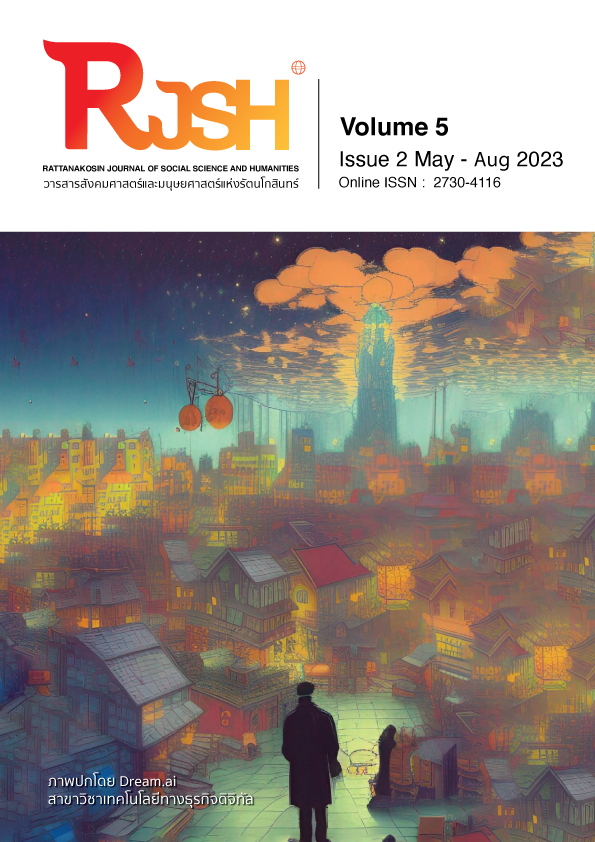Comparison of First-year Students' Academic Achievement Between On-Site and Online Gems and Jewelry Preparation Activities
Main Article Content
Abstract
The purposes of this study are 1) to evaluate first-year students' preparation activities and compare their online and on-site accomplishments in gems and jewelry learning, 2) to investigate the effectiveness of gems and jewelry preparation processes, aiming to achieve the 80/80 criterion for effectiveness, and 3) to research the effectiveness index of first-year students who participated in gems and jewelry-making activities. The sample group consisted of 28 first-year students from the Faculty of Gems at the Burapha University Chanthaburi Campus. The study encompasses two primary research tools: knowledge dissemination mediums for readiness in the field of gems and ornaments, and assessment questionnaires aimed at juxtaposing the efficacy of various learning outcomes. The preparation activities for gems and jewelry were categorized into four groups: 1) general understanding of gems and jewelry, 2) instruments for gem analysis, 3) metals frequently used in jewelry making, and 4) diamond grading. The study's findings showed that 1) There was a significant difference in the achievement levels of activities related to gems and jewelry preparation; on-site performance was higher than online performance, with statistical significance level of 0.05. 2) The efficiency of preparatory efforts was 86.9/93.2, surpassing the benchmark efficiency of 80/80. 3) First-year students engaging in gems and jewelry preparation activities demonstrated an efficacy value of 0.85.
Article Details

This work is licensed under a Creative Commons Attribution-NonCommercial-NoDerivatives 4.0 International License.
The content within the published articles, including images and tables, is copyrighted by Rajamangala University of Technology Rattanakosin. Any use of the article's content, text, ideas, images, or tables for commercial purposes in various formats requires permission from the journal's editorial board.
Rajamangala University of Technology Rattanakosin permits the use and dissemination of article files under the condition that proper attribution to the journal is provided and the content is not used for commercial purposes.
The opinions and views expressed in the articles are solely those of the respective authors and are not associated with Rajamangala University of Technology Rattanakosin or other faculty members in the university. The authors bear full responsibility for the content of their articles, including any errors, and are responsible for the content and editorial review. The editorial board is not responsible for the content or views expressed in the articles.
References
จิณณา ผลดี. (27 กรกฎาคม 2565). การเรียนออนไลน์และเรียนในชั้นเรียนแตกต่างกันอย่างไร. รู้งี้ Edutainment. https://ruungi.com/online-onsite-class/
จีรวรรณ สรบุญทอง, บุษบา บัวสมบูรณ์ และ กิ่งกาญจน์ บูรณสินวัฒนกู. (2564). การศึกษาผลสัมฤทธิ์ ทางการเรียนวรรณคดีไทยและทักษะการร่วมมือของนักเรียนชั้นมัธยมศึกษาปีที่ 1 ที่จัดการเรียนรู้โดยใช้เทคนิคจิ๊กซอว์ 3 ร่วมกับการใช้คำถามพัฒนาการคิด. วารสารจันทรเกษมสาร, 27(1), 89-105.
ชัยยงค์ พรหมวงศ์. (2556). การทดสอบประสิทธิภาพสื่อหรือชุดการสอน. วารสารศิลปากรศึกษาศาสตร์วิจัย, 5(1), 7-20.
ณิชกานต์ แก้วจันทร์ และ ธนินท์รัฐ รัตนพงศ์ภิญโญ. (2564). ความพร้อมในการจัดการเรียนการสอน และความคาดหวังประสิทธิผลการศึกษาในระบบการเรียนการสอนออนไลน์ในทรรศนะของนักศึกษาคณะวิทยาการจัดการ มหาวิทยาลัยศิลปากร (รายงานวิจัย). มหาวิทยาลัยศิลปากร เพชรบุรี.
ณัฐธนากร รักชาติ และสุชาวดี เกษมณี. (2564) การเปรียบเทียบผลสัมฤทธิ์ทางการเรียนระหว่างการจัดการเรียนรู้แบบออนไลน์ กับการจัดการเรียนการรู้แบบออนไซต์วิชาภาษาไทย ของนักเรียนชั้นมัธยมศึกษาปีที่ 6. วารสารมนุษยศาสตร์และสังคมศาสตร์ วไลยอลงกรณ์ ในพระบรมราชูปถัมภ์, 16(2), 81-90.
ณรงค์กร สุทธิศักดา. (2558). การเปรียบเทียบผลสัมฤทธิ์ทางการเรียนวิชาคอมพิวเตอร์เรื่องการสร้างเว็บเพจของนักเรียนชั้นประถมศึกษาปีที่ 6 ที่ได้รับการจัดการเรียนรู้ด้วยบทเรียนคอมพิวเตอร์ช่วยสอนกับที่ได้รับการเรียนรู้แบบปกติ (สารนิพนธ์ปริญญามหาบัณฑิต). มหาวิทยาลัยหาดใหญ่ สงขลา.
ธนพรรณ ทรัพย์ธนาดล. (2563). ปัจจัยที่มีผลกระทบต่อการจัดการเรียนการสอนบทเรียน ออนไลน์ ของมหาวิทยาลัยราชภัฎนครราชสีมา. วารสารอิเล็กทรอนิกส์ Veridian มหาวิทยาลัยศิลปากร (มนุษยศาสตร์สังคมศาสตร์และศิลปะ), 4(1), 652-666.
นฤมล ฉันทมิตร. (2558). ปัจจัยที่สัมพันธ์กับผลสัมฤทธิ์ทางการเรียนของนิสิตชั้นประถมศึกษาปีที่ 6 (วิทยานิพนธ์ปริญญามหาบัณฑิต). มหาวิทยาลัยบูรพา ชลบุรี.
ประสพชัย พสุนนท์. (2557). ความเชื่อมั่นของแบบสอบถามในการวิจัยเชิงปริมาณ. วารสารปาริชาต, 27(1), 144-163.
วิทยา วาโย, อภิรดี เจริญนุกูล, ฉัตรสุดา กานกายันต์ และจรรยา คนใหญ่. (2563). การเรียนการสอนแบบออนไลน์ภายใต้สถานการณ์แพร่ระบาดของไวรัส COVID-19 : แนวคิดและการประยุกต์ใช้จัดการเรียนการสอน. วารสารศูนย์อนามัยที่ 9, 14(34), 285-298.
วรรณี อึ้งสิทธิพูนพร. (2558). ความพึงพอใจในการฝึกอบรมการใช้ภาษาอังกฤษในชั้นเรียนของครูภาษาอังกฤษใน. วารสารอิเล็กทรอนิกส์ Veridian มหาวิทยาลัยศิลปากร (มนุษยศาสตร์สังคมศาสตร์และศิลปะ), 8(3). 1023-1036.
สมรัก บูรณะ. (2553). การเปรียบเทียบผลสัมฤทธิ์ทางการเรียนกลุ่มสาระวิทยาศาสตร์ รายวิชาชีววิทยา ระหว่างการเรียนด้วยบทเรียนคอมพิวเตอร์ช่วยสอนกับการเรียนตามปกติของนักเรียนชั้นมัธยมศึกษาปีที่ 5. วารสารรามคำแหง, 27(3), 286-298.
เสาวลักษ์ รักชอบ. (2560). การพัฒนาความรู้ความเข้าใจในวิชาพื้นฐานคอมพิวเตอร์และเทคโนโลยีสารสนเทศโดยใช้เทคนิคการเรียนรู้แบบร่วมมือ (STAD) ของนักศึกษาสาขาวิชาคอมพิวเตอร์ธุรกิจ มหาวิทยาลัยราชภัฏศรีสะเกษ (รายงานการวิจัย). คณะบริหารธุรกิจและการบัญชี มหาวิทยาลัยราชภัฏศรีสะเกษ.
Goodman, R. I., Fletcher, K. A., & Schneider, E. W. (1980). The effectiveness index as a comparative measure in media product evaluations. Educational Technology, 20(9), 30-34.
Kuder, G. F., & Richardson, M. W. (1937). The theory of the estimation of test reliability. Psychometrika, 2(3), 151-160.


